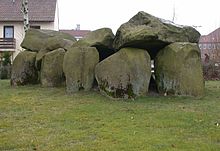Hünenstein (Osterholz-Scharmbeck)
| Hünenstein (Osterholz-Scharmbeck) | ||
|---|---|---|
|
Stone grave in Osterholz-Scharmbeck (front) |
||
|
|
||
| Coordinates | 53 ° 13 '35 " N , 8 ° 47' 52" E | |
| place | Osterholz-Scharmbeck , Lower Saxony , Germany | |
| Emergence | 3500 to 2800 BC Chr. | |
| Sprockhoff no. | 630 | |
The Hünenstein is a Neolithic megalithic complex in Osterholz-Scharmbeck in the Elbe-Weser triangle in Lower Saxony . The complete large stone grave with the Sprockhoff no. 630 was created between 3500 and 2800 BC. BC as a megalithic system of the funnel beaker culture (TBK). Neolithic monuments are an expression of the culture and ideology of Neolithic societies. Their origin and function are considered to be the hallmarks of social development.
history
The trapezoid megalithic tomb in Osterholz-Scharmbeck is six meters long, 1.8 to 2.0 meters wide and almost two meters high. The stone grave has lost a bit of its original height because, during an investigation at the beginning of the 20th century, one of the heavy cap stones slipped in after an attempt to lift it. When it was built, the large stone grave could have been created in the Osterholz Forest , which has largely given way to settlement.
description
The system has ten bearing stones and four cap stones. The largest has the considerable dimensions of 4.5 × 2.5 meters and, at around 30 tons, is one of the heaviest in Germany. The system is also unusually high in the interior. Two cap stones are provided with bowls . A capstone shows blast holes. Access to the complex has not been granted, but it is probably one of the passage graves common in the region . During an excavation in the 18th century, several urns , arrowheads and an ax are said to have been found in the immediate vicinity of the stone grave. There is a copper engraving from 1799.
Archaeological classification
In the summer of 1982 a comprehensive inventory was carried out in the city and district of Osterholz-Scharmbeck by a working group for the preservation of monuments. It was known that (compared to the 19th century) a large number of sites, especially due to the increasing settlement of the area, had to be considered destroyed.
A review of the records of the former district home keeper H. Fitschen, the archaeological survey of the land by HJ Killmann (former soil conservation department in the administrative office) and the years of observation by KP Schultz (head of the district home museum Osterholz) should be carried out in order to clarify the actual existence and gain its condition. According to this, the following aboveground visible monuments were located in the district and city area:
- 9 large stone graves
- 361 burial mounds
- 8 fixings
- 249 Wurten
- 4 cup stones
- 12 other objects
All nine large stone graves are located on the Osterholzer Geest . Based on the numerous characteristic ceramic finds in these facilities, this prehistoric phase is known as the funnel beaker culture .
Note
The "Hünengrab" is freely accessible and is located at the intersection of Am Hünenstein - Osterholzer Strasse about 150 meters from the town hall.
See also
literature
- Ernst Andreas Friedrich : The Hünenstein in Osterholz-Scharmbeck. In: If stones could talk. Volume III, Landbuch-Verlag, Hanover 1995, ISBN 3-7842-0515-1 , pp. 16-18.
- Johann Segelken: Osterholz-Scharmbeck Heimatbuch , Saade Verlag, Osterholz-Scharmbeck 1987
- Ernst Sprockhoff : Atlas of the megalithic tombs of Germany. Part 3: Lower Saxony - Westphalia. Rudolf-Habelt Verlag, Bonn 1975, ISBN 3-7749-1326-9 , p. 13.
Web links
Individual evidence
- ↑ J. Müller In: Varia neolithica VI 2009 p. 15


